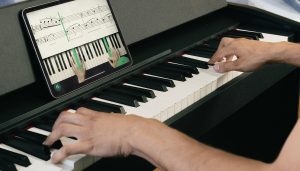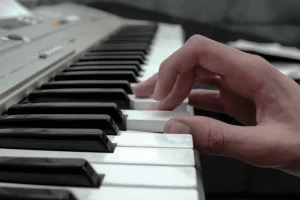Hand rotation is an important yet often overlooked element of piano technique. Hand rotation involved the subtle and controlled rotation of the hands to facilitate more smooth and efficient playing. Understanding and implementing proper hand rotation can enhance your playing, reduce strain on your arms, and increase your speed and accuracy.
In this article, we will explore hand rotation, learn about single and double hand rotations, some relevant applications in classical music, some strategies you can use to practice hand rotations, and how hand rotation can improve your overall piano performance.

Understanding hand rotation
Hand rotation in piano playing refers to the movement of the hands around the forearm axis, enabling smoother transitions between notes and chords. This movement is subtle and often involves a slight tilting of the hand, allowing the fingers to naturally fall into place on the keys.
Hand rotation helps minimize unnecessary finger and wrist movements, promoting a more relaxed and efficient playing style. The role of hand rotation in piano technique is to facilitate better control over finger movements, reduce tension, and enhance the overall fluidity of playing.
By using hand rotation, pianists can achieve more accurate finger placement, which is especially beneficial in rapid passages, complex chords, and jumps. This technique also helps in preventing injuries caused by repetitive strain, as it encourages a more ergonomic playing posture.
The concept of hand rotation has been part of piano pedagogy for centuries, though it has often been an implicit part rather than explicitly taught. In recent years, however, there has been a growing emphasis on its importance, with many teachers and methods incorporating it into their instruction.
Single hand rotation
Single-hand rotation involves rotating the hand in one direction, either clockwise or counterclockwise, to facilitate playing. This rotation is typically used when moving between notes or chords positioned at different levels on the keyboard, such as in arpeggios, passages with wide intervals, and even some easy piano songs. The primary goal of the single-hand rotation is to align the fingers with the keys they are about to play, thereby reducing the need for excessive finger movement.
Single-hand rotation is commonly used in pieces that require smooth transitions between notes or chords, such as legato playing or pieces with flowing, melodic lines. For instance, in Chopin’s Nocturnes or Debussy’s Clair de Lune, single-hand rotation helps achieve the seamless flow of notes, enhancing the musical expression, phrasing, and hand independence.
To master single-hand rotation, pianists should practice exercises for your hands slowly and deliberately, focusing on the smoothness of the rotation and the relaxation of the hand and wrist. Exercises that involve playing scales, arpeggios, and broken chords are particularly beneficial. It’s important to maintain a relaxed hand position and avoid any unnecessary tension in the wrist or forearm. Practicing in front of a mirror can also help you monitor and refine the movement.
Double hand rotation
Double-hand rotation involves rotating both hands, typically in opposite directions, to accommodate more complex musical passages. This technique is often used in pieces with intricate hand crossings, wide leaps, or passages that require a quick change of hand position. Double hand rotation helps maintain a balanced hand posture, reduces the strain on the fingers and wrists, and allows for smoother transitions between notes.
Examples of double-hand rotation can be found in pieces like Liszt’s Transcendental Études or Rachmaninoff’s Piano Concertos. The rapid movement between registers and dense textures necessitates efficient hand rotation. In these cases, mastering double-hand rotation can significantly improve the pianist’s control and accuracy.
Simple vs. complex rotations
Hand rotations can be categorized into simple and complex rotations based on the complexity of the movements involved and the musical context in which they are used. Simple rotations typically involve a straightforward, single movement of the hand, either in a single direction or in opposite directions. These rotations are generally easier to execute and are used in simpler musical passages.
Complex rotations involve multiple or more intricate movements, often in rapid succession or in combination with other techniques such as hand crossings, wide leaps, or simultaneous movements of the fingers. These rotations are common in intermediate piano songs and advanced repertoire, where the musical demands require a higher level of technical proficiency and coordination.
Identifying simple versus complex rotations in music involves analyzing the passages to understand the hand movements required. Simple rotations are typically found in scales, arpeggios, and passages with straightforward fingerings. Complex rotations are often encountered in pieces with intricate textures, rapid tempo, or complex fingerings.
Benefits of proper hand rotation
Proper hand rotation offers several benefits that can enhance a pianist’s technique and overall playing experience. One of the primary benefits is improved efficiency and accuracy in finger movements. By aligning the fingers with the keys through hand rotation, pianists can achieve more precise finger placement, which is crucial in fast passages or complex pieces.
Another significant benefit is the reduction of physical strain and the prevention of injuries. Repetitive strain injuries, such as tendonitis or carpal tunnel syndrome, are common among pianists. They often result from improper technique or excessive tension in the hands and wrists. Hand rotation promotes a more ergonomic playing posture, distributing the physical workload more evenly and reducing the risk of injury.
Hand rotation also contributes to better musical expression and dynamics. By facilitating smoother transitions between notes and chords, it allows pianists to focus more on the musicality of their playing, such as phrasing, articulation, dynamics, and playing different volumes with each hand. This can enhance the emotional impact of the music and create a more engaging performance.
Famous pianists and teachers have long advocated for the use of hand rotation in piano playing. For instance, pianists like Vladimir Horowitz and Alfred Cortot emphasized the importance of a relaxed and flexible wrist, which is a key component of effective hand rotation. These pianists demonstrated how hand rotation can lead to a more fluid and expressive playing style, which is essential for interpreting complex and nuanced repertoire.
The video below takes you through the benefits of hand rotation in piano playing, which includes taking care of your arms and also playing more complex pieces in a more comfortable way.
💡Tips for success
Here are some strategies you can use today to master hand rotation and integrate it into your playing. These tips are useful for all aspects of piano playing and can be applied to learn many different techniques.
| Warm-up exercises and stretches | Begin your practice sessions with gentle stretches for your hands, wrists, and forearms. This helps loosen the muscles and prepare them for the demands of playing. To build muscle memory, incorporate warm-up exercises that focus on hand rotation, such as slow scales and arpeggios. |
| Slow practice and proper posture | Practice slowly to focus on the smoothness and accuracy of your hand rotations. Pay attention to your posture, ensuring that your hands, wrists, and arms are relaxed and aligned. Avoid any unnecessary tension, which can impede your playing and increase the risk of injury. |
| Focus on relaxation | Relaxation is key to effective hand rotation. Ensure that your hands and wrists remain loose and flexible, especially during fast or complex passages. Practice relaxation techniques, such as deep breathing or visualization, to help maintain a calm and focused mindset. |
| Use visualizations and mental practice | Visualize the hand movements and rotations required for a piece before playing. This mental practice can reinforce your understanding of the technique and improve your muscle memory. Imagine the flow of the music and how your hands will move across the keyboard. |
| Seek feedback | Regularly seek feedback from teachers, coaches, or more experienced pianists. They can provide valuable insights into your technique and offer suggestions for improvement. Recording your practice sessions and reviewing them can also help identify areas that need work. |
How Skoove can help
Skoove is a popular online piano learning platform that offers interactive lessons and personalized feedback to help pianists improve their skills.
One of the key advantages of Skoove is its ability to provide real-time feedback on your playing, helping you to identify and correct any issues with hand rotation or other aspects of technique.
The platform’s lessons are designed to guide you through various aspects of piano playing, including hand rotation.
Skoove’s interactive approach allows you to practice at your own pace, with lessons tailored to your skill level and goals. This flexibility is particularly beneficial for mastering techniques like hand rotation, as you can focus on specific exercises and pieces that target this skill.
Skoove’s emphasis on a holistic approach to learning, which includes theory, technique, and musicality, makes it a valuable resource for pianists looking to improve their hand rotation and overall playing. By incorporating Skoove into your practice routine, you can receive personalized guidance and feedback, helping you to achieve your piano goals more effectively.
Hand rotation is key!
Hand rotation is an important aspect of piano technique that is often overlooked. However, proper hand rotation can significantly enhance your piano playing. Mastering the techniques of single and double rotations can lead to greater efficiency, accuracy, and eventually help you expand your musical expression. Additionally, it can help prevent injuries and promotes a better playing posture.
As you work on improving your hand rotation, remember the importance of patience and consistent practice. Incorporate the tips and exercises discussed in this article into your practice routine, and seek feedback from resources like Skoove to refine your technique further!
Author of this blog post:
Susana Pérez Posada

With over seven years of piano education and a deep passion for music therapy, Susana brings a unique blend of expertise to Skoove. A graduate in Music Therapy from SRH Hochschule Heidelberg and an experienced classical pianist from Universidad EAFIT, she infuses her teaching with a holistic approach that transcends traditional piano lessons. Susana’s writings for Skoove combine her rich musical knowledge with engaging storytelling, enriching the learning experience for pianists of all levels. Away from the piano, she loves exploring new places and immersing herself in a good book, believing these diverse experiences enhance her creative teaching style.
Published by Lydia Ogn from the Skoove team














